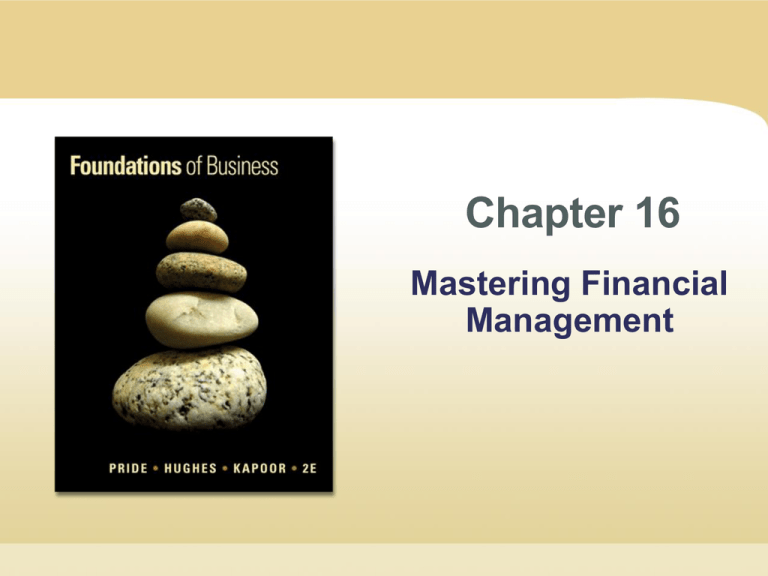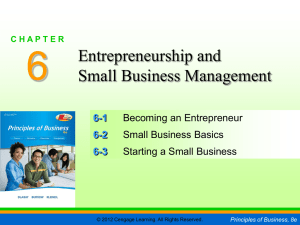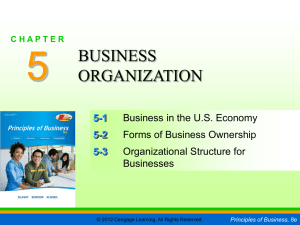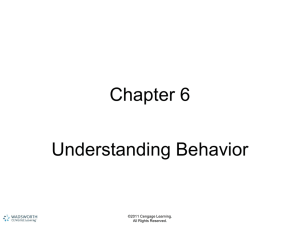
Chapter 16
Mastering Financial
Management
Learning Objectives
1. Explain the need for financial management in business.
2. Summarize the process of planning for financial
management.
3. Identify the services provided by banks and financial
institutions for their business customers.
4. Describe the advantages and disadvantages of
different methods of short-term debt financing.
5. Evaluate the advantages and disadvantages of
equity financing.
6. Evaluate the advantages and disadvantages of
long-term debt financing.
Copyright © Cengage Learning. All rights reserved.
Chapter 16 | Slide 2
Financial Management
…all the activities concerned with obtaining
money and using it effectively.
Copyright © Cengage Learning. All rights reserved.
Chapter 16 | Slide 3
Need for Financing
Reasons:
• Start a business
• Keep it going
Sources:
• Owners’ investment
• Borrowed
Afterward:
• Pay expenses
• Provide profit
Copyright © Cengage Learning. All rights reserved.
Chapter 16 | Slide 4
Short-Term Financing
…money that will be used
for one year or less.
Copyright © Cengage Learning. All rights reserved.
Chapter 16 | Slide 5
Table 16.1:
Comparison of Short- and Long-Term Financing
Whether a business seeks short- or long-term financing
depends on what the money will be used for.
Copyright © Cengage Learning. All rights reserved.
Chapter 16 | Slide 6
Cash Flow
…the movement of money into and
out of an organization.
Copyright © Cengage Learning. All rights reserved.
Chapter 16 | Slide 7
The Cash Flow Cycle
Sales
Accounts
Receivable
Inventory
Cash
Copyright © Cengage Learning. All rights reserved.
Chapter 16 | Slide 8
Speculative Production
…the time lag between actual production of
goods and when the goods are sold.
Copyright © Cengage Learning. All rights reserved.
Chapter 16 | Slide 9
Figure 16.1:
Cash Flow for a Manufacturing Business
Copyright © Cengage Learning. All rights reserved.
Chapter 16 | Slide 10
Long-Term Financing
…money that will be used for
longer than one year.
Copyright © Cengage Learning. All rights reserved.
Chapter 16 | Slide 11
Two-Sided Problem of Financing
Uses of funds dictate
type(s) of financing
needed
Activities undertaken
determined by types
of financing available
Copyright © Cengage Learning. All rights reserved.
Chapter 16 | Slide 12
Risk-Return Ratio
…a ratio based on the principle that
a high-risk decision should generate
higher financial returns for a business
and more conservative decisions often
generate lesser returns.
Copyright © Cengage Learning. All rights reserved.
Chapter 16 | Slide 13
Proper Financial Management
Financing priorities
established with goals
and objectives
Spending
planned/controlled
Bills paid promptly
Excess cash invested
Copyright © Cengage Learning. All rights reserved.
Chapter 16 | Slide 14
Careers in Finance
Chief Financial Officer (CFO): manages
firm’s finances, reports to chief executive
officer or president
Lower-level positions: banking, insurance,
investment, non-profits, government entities
Requirements:
• Strong background in accounting/math
• Knowledge of computer use for data
analysis
• Expertise in written/oral communication
Copyright © Cengage Learning. All rights reserved.
Chapter 16 | Slide 15
Positions, Salaries, and Experience
at Two Major Firms
Title
GMC
Pepsico
Exp./Education
Junior Fin.
Anal.
$20-43.2K
$45-50K
B.B.A.
Senior Fin.
Anal.
$46.9-82.6K
$60-70K
3yr/MBA
Division
Controller
$110-172K
$70-80K
10yr/MBA
CFO
$200-350K
$150-200K
15yr/MBA
Swiss Finance Academy, “Corporate Finance Salaries,” www.careers-in-finance.com/cfsal.htm, accessed September 27, 2009.
Copyright © Cengage Learning. All rights reserved.
Chapter 16 | Slide 16
Financial Plan
…a plan for obtaining and
using money needed to implement
an organization’s goals.
Copyright © Cengage Learning. All rights reserved.
Chapter 16 | Slide 17
Developing Financial Plan
Establish Goals
and Objectives
Budget for Needs
Monitor &
Evaluate
Performance
Identify Sources
Copyright © Cengage Learning. All rights reserved.
Chapter 16 | Slide 18
Figure 16.2:
The Three Steps of Financial Planning
Copyright © Cengage Learning. All rights reserved.
Chapter 16 | Slide 19
Budget
…a financial statement that projects
income and/or expenditures over a
specified future period.
Copyright © Cengage Learning. All rights reserved.
Chapter 16 | Slide 20
Figure 16.3: Sales Budget
Copyright © Cengage Learning. All rights reserved.
Chapter 16 | Slide 21
Cash Budget
…a financial statement that projects
cash receipts and cash expenditures
over a specified period.
Copyright © Cengage Learning. All rights reserved.
Chapter 16 | Slide 22
Figure 16.4: Cash Budget
Copyright © Cengage Learning. All rights reserved.
Chapter 16 | Slide 23
Capital Budget
…a financial statement that estimates a
firm’s expenditures for major assets and its
long-term financing needs.
Copyright © Cengage Learning. All rights reserved.
Chapter 16 | Slide 24
Approaches to Budgeting
Traditional: base on budget of preceding year;
modify to reflect revised goals and objectives;
justify only new expenditures
Zero-base: justify every expense
Copyright © Cengage Learning. All rights reserved.
Chapter 16 | Slide 25
Primary Sources of Funds
Sales Revenue
Equity Capital
Debt Capital
Sales of Assets
Copyright © Cengage Learning. All rights reserved.
Chapter 16 | Slide 26
Financial Services Provided by
Banks and Other Financial Institutions
Traditional
•
•
Savings and Checking Accounts
Business Loans
Electronic Banking
•
•
•
Automated Clearinghouses (ACHs)
Point of Sale (POS) Terminals
Electronic Check Conversion (ECC)
International
•
•
Letter of Credit
Bankers Acceptance
Copyright © Cengage Learning. All rights reserved.
Chapter 16 | Slide 27
Traditional Business Banking Services
1. Savings and Checking Accounts
a) Passbook Savings
b) Certificate of Deposit
c) Check
2. Business Loans
a)
b)
c)
d)
Short-Term Loans
Line of Credit
Revolving Credit
Long-Term Loans
3. Credit/Debit Card Transactions
Copyright © Cengage Learning. All rights reserved.
Chapter 16 | Slide 28
Electronic Funds Transfer
…a means of performing financial
transactions through a computer
terminal or telephone hookup.
Copyright © Cengage Learning. All rights reserved.
Chapter 16 | Slide 29
Sources of Unsecured
Short-Term Financing
Unsecured financing is financing that is
not backed by collateral.
Trade Credit
Promissory Note
Unsecured Bank Loans
Commercial Paper
Copyright © Cengage Learning. All rights reserved.
Chapter 16 | Slide 30
Average Prime Interest Rate
Source: Federal Reserve Bank website, www.federalreserve.gov, accessed October 17, 2008..
Copyright © Cengage Learning. All rights reserved.
Chapter 16 | Slide 31
Sources of Secured Short-Term Financing
Inventory
Accounts ReceivableFactoring
Copyright © Cengage Learning. All rights reserved.
Chapter 16 | Slide 32
Table 16.2:
Comparison of Short-Term Financing Methods
Copyright © Cengage Learning. All rights reserved.
Chapter 16 | Slide 33
Sources of Equity Financing
Sale of Stock
• Initial Public Offering: common stock sold the
first time to public
• Investment Banking Firm: assists firm in
raising capital
Retained Earnings: undistributed portion of
firm’s profits
Private Placement: securities sold directly to
insurance companies, pension funds, large
institutions, wealthy investors
Copyright © Cengage Learning. All rights reserved.
Chapter 16 | Slide 34
Using the Internet
• The New York Stock Exchange and the
NASDAQ are the two most cited equity
markets. Each provides financial information
about the companies it lists and news that
might influence their stock values.
www.nyse.com
www.nasdaq.com
Copyright © Cengage Learning. All rights reserved.
Chapter 16 | Slide 35
Spotlight
IPOs Can Raise Billions!
Source: The Renaissance Capital IPO Home website, www.ipohome.com,
accessed May 24, 2009.
Copyright © Cengage Learning. All rights reserved.
Chapter 16 | Slide 36
Types of Stock
Common
• Holders vote on corporate matters
• Holders’ claims on profits/assets subordinate to
preferred
Preferred
• Holders receive dividends first
• Dividend is specified
Convertible Preferred can be exchanged
for common
Copyright © Cengage Learning. All rights reserved.
Chapter 16 | Slide 37
Sources of
Long-Term Debt Financing
Financial Leverage
Use of borrowed funds to
increase return on
owners’ equity
Term Loan
Borrower required to
repay loan in monthly,
quarterly, semiannual, or
annual installments
Copyright © Cengage Learning. All rights reserved.
Chapter 16 | Slide 38
Corporate Bond
…a corporation’s written pledge that
it will repay a specified amount of
money with interest.
The maturity date is the date on which the
amount borrowed must be repaid.
Copyright © Cengage Learning. All rights reserved.
Chapter 16 | Slide 39
Types of Bonds
1. Registered: registered in owner’s name
by issuing company
2. Debenture: backed only by issuing
firm’s reputation
3. Mortgage: secured by assets of firm
4. Convertible: may be exchanged for a
specified number of common stock shares
Copyright © Cengage Learning. All rights reserved.
Chapter 16 | Slide 40
Bond Provisions
Maturity date: 10 to 30 years
Indenture: details conditions of bond issue
Serial Bonds: single issue that matures on
different dates
Sinking fund: deposits made each year for
purpose of redeeming bond issue
Trustee: acts as bond owners’ representative
Copyright © Cengage Learning. All rights reserved.
Chapter 16 | Slide 41
Table 16.4:
Comparison of Long-Term Financing Methods
Copyright © Cengage Learning. All rights reserved.
Chapter 16 | Slide 42
Chapter Quiz
1. Which of the following would be considered a shortterm financial need?
a)
b)
c)
d)
e)
New product development
Cash flow problems
Business start-up costs
Mergers and acquisitions
Expansion of facilities
Copyright © Cengage Learning. All rights reserved.
Chapter 16 | Slide 43
Chapter Quiz
2. The least expensive form of short-term financing is
a)
b)
c)
d)
e)
promissory notes.
prime rate loans.
common stock.
trade credit.
factoring.
Copyright © Cengage Learning. All rights reserved.
Chapter 16 | Slide 44
Chapter Quiz
3. Which of the following statements is incorrect?
a) A corporation can issue only common stock or
preferred stock, but not both.
b) IPO stands for initial public offering.
c) Common stockholders have the right to vote on
major corporate actions.
d) A corporation is under no legal obligation to pay
dividends to common stockholders.
e) A corporation is under no legal obligation to buy
back the stock you purchase.
Copyright © Cengage Learning. All rights reserved.
Chapter 16 | Slide 45
Chapter Quiz
4. The portion of a corporation’s profits not distributed
to stockholders is called
a)
b)
c)
d)
e)
retained earnings.
undistributed profits.
profit residue.
income before taxes.
net profit.
Copyright © Cengage Learning. All rights reserved.
Chapter 16 | Slide 46
Chapter Quiz
5. A __________ is the legal document that details all
the conditions relating to a bond issue.
a)
b)
c)
d)
e)
bond indenture
debenture statement
bond contract
security agreement
collateral statement
Copyright © Cengage Learning. All rights reserved.
Chapter 16 | Slide 47








